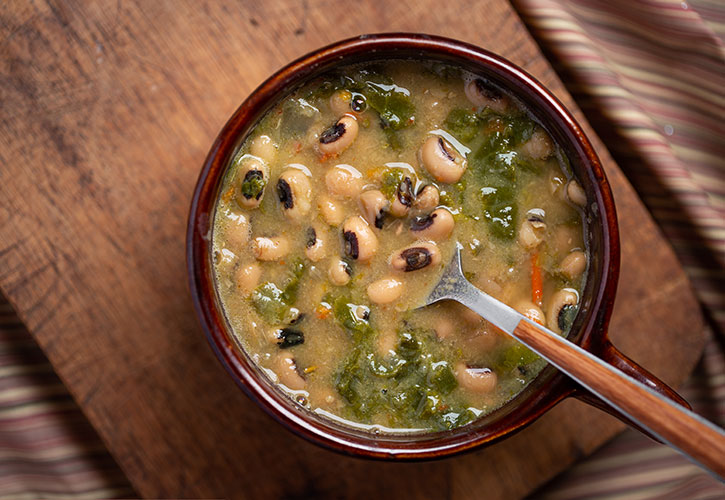Cuando los días se vuelven fríos y ventosos, abrígate con nuestras sopas reconfortantes y saludables de invierno. Las sopas caseras son fáciles de preparar y muy sabrosas; además, a los niños les divierte sorberlas. Nuestras sopas de camote y frijoles negros están elaboradas con muchos vegetales, por lo que cada cucharada aporta muchos nutrientes a la dieta de tu familia.

Sopas con sentido y sabor: sopa fácil de frijoles negros
- Home
- Live Well Blog
- Sopas con sentido y sabor: sopa fácil de frijoles negros
diciembre 7, 2022
General / FamiliaRecetas

Hacer esta receta te llevará solo 5 minutos, porque lleva dos ingredientes convenientes: frijoles enlatados y maíz congelado. Puedes elevar su sabor al agregar más comino y chile en polvo, u optar por una salsa más picante. Sírvela acompañada de diversos ingredientes adicionales y deja que tus hijos elijan sus favoritos.
Sopa fácil de frijoles negros
RINDE 4 PORCIONES
- Una lata de 15 onzas de frijoles negros sin escurrir
- 1 ½ taza de granos de maíz congelados
- ¾ taza de salsa
- ½ taza de agua
- Jugo de 1 lima (2 cucharadas)
- ½ cucharadita de comino molido
- ½ cucharadita de chile en polvo
- Coloca los frijoles sin colar, el maíz, la salsa, el agua, el jugo de lima, el comino y el chile en polvo en una olla mediana y mézclalos.
- Lleva a fuego fuerte hasta que hierva. Baja la llama y cocina a fuego bajo por unos 5 minutos, revolviendo ocasionalmente, hasta que la sopa esté caliente.
- Sírvela con los ingredientes adicionales opcionales.
Opciones de ingredientes adicionales para servir: Queso rallado bajo en grasas, crema agria light, aguacate en cubos, cilantro fresco.
CONSEJO: Si no tienes frijoles negros, puedes reemplazarlos por pintos, rojos o caupí.
Información nutricional por porción (aproximadamente 1 taza):
140 calorías, 0 g de grasa, 210 mg de sodio, 30 g de hidratos de carbono, 6 g de fibra, 6 g de proteína, 10 % de vitamina C.Sopas con sentido y sabor
Muchas sopas caseras incorporan frijoles, proteínas y gran cantidad de vegetales; por eso, cada cucharada aporta sabor y son muy nutritivas.
Estos son algunos aspectos que se deben tener en cuenta para comprar y comer sopas saludables:
Ojo con la sal:
Las sopas compradas son una de las 10 fuentes principales de sodio en la dieta de los niños, y demasiada sal puede aumentar el riesgo de tener presión arterial alta. Para evitarlo, lee las etiquetas de las sopas antes de comprarlas, compara marcas, y elige las alternativas con menos sodio en el mercado.
Según las Pautas alimentarias para los estadounidenses de 2020, se debe limitar la ingesta diaria de sodio a los siguientes valores:
- adultos y adolescentes de 14 años o más: máximo de 2300 mg;
- niños de 9 a 13 años: máximo de 1800 mg;
- niños de 4 a 8 años: máximo de 1500 mg;
- niños de 1 a 3 años: máximo de 1200 mg.


- Añade vegetales:
- Las sopas son una manera sencilla de aportar una gran variedad de vegetales nutritivos a la dieta de tu familia. Opta por sopas enlatadas que contengan ingredientes como frijoles, lentejas, zanahorias, guisantes, judías verdes y tomate. Si abres una lata que no tiene tantos vegetales, puedes agregarle algunos congelados o enlatados.
- Un giro saludable a las sopas enlatadas:
- Al preparar sopas enlatadas, agrega leche en lugar de agua para aumentar la cantidad de calcio, que ayuda a fortalecer los huesos. También puedes agregarles ingredientes adicionales. Por ejemplo, añadir hongos rebanados y salteados a la sopa crema de hongos la hace mucho más sustanciosa; y agregar pollo cocido en cubos aporta proteína adicional a la sopa crema de pollo.
